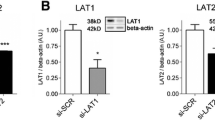Abstract
Using intact villous fragments from normal term placentas, the authors characterize the e fect of reduced amino acid availability on amino acid uptake via the system A amino acid transporter. Villous fragments deprived of amino acids demonstrate increased system A activity compared with those incubated in an amino acid—su ficient medium (P <.05). Similarly, placental villous fragments exposed to media containing only amino acids not specifically transported by system A have a significant increase in system A activity compared with villous fragments incubated in an amino acid—su ficient medium containing only substrates of system A (P <.05). There is a significant trend for increasing system A activity as the concentrations of the system A amino acid substrates are decreased (P <.01). Collectively, these data indicate that normal placentas can increase system A amino acid transporter activity in a substrate-specific and dose-dependent manner as a means to ensure optimal fetal growth in the presence of amino acid limitation.
Similar content being viewed by others
References
Kramer MS, Kakuma R. Energy and protein intake in pregnancy. Cochrane Database Syst Rev. 2003(4):CD000032.
Eskenazi B., Fenster L., Sidney S., Elkin EP Fetal growth retardation in infants of multiparous and nulliparous women with preeclampsia. Am J Obstet Gynecol. 1993;169:1112–1118.
Jansson T., Powell TL IFPA 2005 Award in Placentology Lecture. Human placental transport in altered fetal growth: does the placenta function as a nutrient sensor? A review. Placenta. 2006;27(suppl A):S91–S97.
Bauer MK, Harding JE, Bassett NS, et al. Fetal growth and placental function. Mol Cell Endocrinol. 1998;140(1–2):115–120.
Johnson LW, Smith CH Neutral amino acid transport systems of microvillous membrane of human placenta. Am J Physiol. 1988;254(6 pt 1):C773–C780.
Gazzola RF, Sala R., Bussolati O., et al.The adaptive regulation of amino acid transport system A is associated to changes in ATA2 expression. FEBS Lett. 2001;490(1–2):11–14.
Kilberg MS Amino acid transport in isolated rat hepatocytes. J Membr Biol. 1982;69(1):1–12.
Ling R., Bridges CC, Sugawara M., et al. Involvement of transporter recruitment as well as gene expression in the substrate-induced adaptive regulation of amino acid transport system A. Biochim Biophys Acta. 2001;1512(1):15–21.
Tanaka K., Yamamoto A., Fujita T. Functional expression and adaptive regulation of Na+-dependent neutral amino acid transporter SNAT2/ATA2 in normal human astrocytes under amino acid starved condition. Neurosci Lett. 2005;378(2):70–75.
Jones HN, Ashworth CJ, Page KR, McArdle HJ Expression and adaptive regulation of amino acid transport system A in a placental cell line under amino acid restriction. Reproduction. 2006;131(5):951–960.
Novak D., Quiggle F., Haafiz A. Impact of forskolin and amino acid depletion upon system A activity and SNAT expression in BeWo cells. Biochimie. 2006;88(1):39–44.
Shibata E., Powers RW, Rajakumar A., et al. Angiotensin II decreases system A amino acid transporter activity in human placental villous fragments through AT1 receptor activation. Am J Physiol Endocrinol Metab. 2006;291(5):E1009–E1016.
Jansson N., Greenwood SL, Johansson BR, Powell TL, Jansson T. Leptin stimulates the activity of the system A amino acid transporter in human placental villous fragments. J Clin Endocrinol Metab. 2003;88(3):1205–1211.
Cetin I., Ronzoni S., Marconi AM, et al. Maternal concentrations and fetal-maternal concentration differences of plasma amino acids in normal and intrauterine growth-restricted pregnancies. Am J Obstet Gynecol. 1996;174(5):1575–1583.
Terrlink T., van Leeuwen PA, Houdijk A. Plasma amino acids determined by liquid chromatography within 17 minutes. Clin Chem. 1994;40(2):245–249.
Bradford MM A rapid and sensitive method for the quantitation of microgram quantities of protein utilizing the principle of protein-dye binding. Anal Biochem. 1976;72: 248–254.
Greenwood SL, Sibley CP In vitro methods for studying human placental amino acid transport placental villous fragments. Methods Mol Med. 2006;122:253–264.
Sooranna SR, Oteng-Ntim E., Meah R., Ryder TA, Bajoria R. Characterization of human placental explants: morphological, biochemical and physiological studies using first and third trimester placenta. Hum Reprod. 1999;14(2):536–541.
Battaglia FC, Regnault TR Placental transport and metabolism of amino acids. Placenta. 2001;22(2–3):145–161.
Jansson T. Amino acid transporters in the human placenta. Pediatr Res. 2001;49(2):141–147.
Desforges M., Lacey HA, Glazier JD, et al. SNAT4 isoform of system A amino acid transporter is expressed in human placenta. Am J Physiol Cell Physiol. 2006;290(1):C305–C312.
Jones CR, Srinivas SR, Devoe LD, Ganapathy V., Prasad PD Inhibition of system A amino acid transport activity by ethanol in BeWo choriocarcinoma cells. Am J Obstet Gynecol. 2002;187(1):209–216.
Evans RW, Powers RW, Ness RB, et al. Maternal and fetal amino acid concentrations and fetal outcomes during preeclampsia. Reproduction. 2003;125(6):785–790.
Author information
Authors and Affiliations
Corresponding author
Additional information
This study was supported by National Institutes of Health grants HD-30367 and MO1-RR-00056. Meredith Snook Parrott was supported by a Clinical Scientist Training Program scholarship from the University of Pittsburgh School of Medicine.
Rights and permissions
About this article
Cite this article
Parrott, M.S., von Versen-Hoeynck, F., Ness, R.B. et al. System A Amino Acid Transporter Activity in Term Placenta Is Substrate Specific and Inversely Related to Amino Acid Concentration. Reprod. Sci. 14, 687–693 (2007). https://doi.org/10.1177/1933719107306895
Published:
Issue Date:
DOI: https://doi.org/10.1177/1933719107306895




